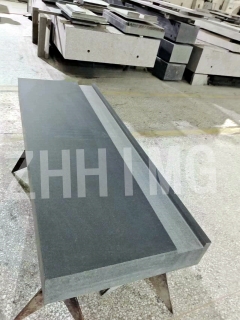Granite machine beds are commonly used in the manufacturing and testing of high precision equipment, such as AUTOMATION TECHNOLOGY products. The accuracy of these products depends largely on the precision of the granite machine bed. Therefore, it is crucial to assemble, test and calibrate the granite machine bed properly. In this article, we will discuss the steps required to assemble, test and calibrate a granite machine bed for AUTOMATION TECHNOLOGY products.
Step 1: Assembling the Granite Machine Bed
Firstly, you need to select a high-quality granite slab that is appropriate for the size and weight of the AUTOMATION TECHNOLOGY product. The granite machine bed should be leveled and clamped securely to reduce vibration during testing and calibration. The granite slab should be placed on a foundation that is stable and capable of supporting the load.
Step 2: Testing the Granite Machine Bed
After assembling the granite machine bed, you need to test it to ensure that it is stable and capable of supporting the weight of the AUTOMATION TECHNOLOGY product. To test the granite machine bed, you can use a dial indicator or laser alignment tool to measure the flatness and levelness of the surface. Any deviations should be corrected to ensure that the surface is flat and level.
Step 3: Calibrating the Granite Machine Bed
Once the granite machine bed has been tested and corrected, it is time to calibrate it. Calibration is essential to ensure that the AUTOMATION TECHNOLOGY products have the required accuracy and consistency during operation. To calibrate the granite machine bed, you can use a precision calibration instrument, such as a laser interferometer. The instrument will measure the flatness and levelness of the surface, and any deviations will be corrected accordingly.
Step 4: Verifying Calibration Results
After calibration, you need to verify the calibration results to ensure that the granite machine bed meets the required specifications. You can verify the calibration results using a variety of techniques, such as surface roughness measurement, profile measurement, and coordinate measurement. Any deviations should be corrected to ensure that the granite machine bed meets the required specifications.
Conclusion:
In conclusion, assembling, testing, and calibrating a granite machine bed is a critical process that requires attention to detail and precision. By following these steps, you can ensure that the granite machine bed is stable, level, and accurate, which is essential for producing high-quality AUTOMATION TECHNOLOGY products. Remember to always verify the calibration results to ensure that the granite machine bed meets the required specifications. A well-calibrated granite machine bed will improve the accuracy and consistency of your products, leading to better customer satisfaction.
Post time: Jan-05-2024

